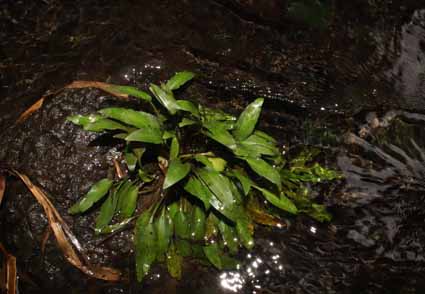Abstract
Recent fieldwork in Zamboanga del Norte resulted in the recollection of the poorly known aquatic aroid, Cryptocoryne pygmaea. In this study, we have clarified the identity of C. pygmaea as well as provided a detailed morphological description based on our recently collected material, updated its geographical distribution information, ecology, phenology, and a proposed conservation status. Through this recollection, it was revealed that plants previously identified as C. pygmaea in Palawan and Busuanga are different, thus we describe them here as C. palawanensis, a species new to science and the eighth representative of the genus for the Philippine archipelago.
References
<p align="justify"><span style="color: #000000;"><span style="font-family: Times New Roman, serif;"><span style="font-size: small;">Bastmeijer, J.D. (2018) The crypts pages. Available from: http://crypts.home.xs4all.nl/Cryptocoryne/index.html (accessed 1 August 2022).</span></span></span>
<p align="justify"><span style="color: #000000;"><span style="font-family: Times New Roman, serif;"><span style="font-size: small;">Bastmeijer, J.D. & Morco, H. (2000) Cryptocoryne pygmaea Merrill (Araceae) von Busuanga und Palawan (Philippinen). Aqua-Planta 25 (3): 99–107.</span></span></span>
<p align="justify"><span style="color: #000000;"><span style="font-family: Times New Roman, serif;"><span style="font-size: small;">Hilleshog Forestry, A.B. (1985) The Palawan Botanical Expedition Final Report.</span></span></span>
<p align="justify"><span style="color: #000000;"><span style="font-family: Times New Roman, serif;"><span style="font-size: small;">IUCN Standards and Petitions Subcommittee. (2022) Guidelines for Using the IUCN Red List Categories and Criteria. Version 15.1. Available from: https://nc.iucnredlist.org/redlist/content/attachment_files/RedListGuidelines.pdf (accessed 12 August 2022)</span></span></span>
<p align="justify"><span style="color: #000000;"><span style="font-family: Times New Roman, serif;"><span style="font-size: small;">Merrill, E.D. (1919) New or noteworthy Philippine plants XV. Philippine Journal of Science. Manila 14: 370–371. https://doi.org/10.5962/bhl.part.14566</span></span></span>
<p align="justify"><span style="color: #000000;"><span style="font-family: Times New Roman, serif;"><span style="font-size: small;">Naive, M.A.K. & Villanueva, R.J.T. (2018) Cryptocoryne joshanii (Araceae), a new species serendipitously discovered in Sulu archipelago, Philippines. Taiwania 63: 248–250.</span></span></span>
<p align="justify"><span style="color: #000000;"><span style="font-family: Times New Roman, serif;"><span style="font-size: small;">Naive, M.A.K., Lagud, Y.J. & Jacobsen, N. (2022) Discovery through citizen science: Cryptocoryne paglaterasiana (Araceae), a new endangered species from Tampilisan, Zamboanga del Norte, Western Mindanao. Taiwania 67: 539–543.</span></span></span>
<p align="justify"><span style="color: #000000;"><span style="font-family: Times New Roman, serif;"><span style="font-size: small;">Rataj, K. (1975) Revision of the genus Cryptocoryne Fischer. Studie ?SAV, ?. 3: 1–174.</span></span></span>
<p align="justify"><span style="color: #000000;"><span style="font-family: Times New Roman, serif;"><span style="font-size: small;">Wit, H.C.D. de. (1990) Aquarienpflanzen, 2. Auflage. Ulmer, Stuttgart.</span></span></span>
<p align="justify"><span style="color: #000000;"><span style="font-family: Times New Roman, serif;"><span style="font-size: small;">Wongso, S., Asih, N.P.S., Bastmeijer, J.D., Reichert, W., Jensen, K.R., Ørgaard, M. & Jacobsen, N. (2019) Four new Cryptocoryne (Araceae) taxa from Sumatera, Indonesia: a new variety and three interspecific natural hybrids. Taiwania 64: 326–338.</span></span></span>
<p align="justify"><span style="color: #000000;"><span style="font-family: Times New Roman, serif;"><span style="font-size: small;">Wydler, H. (1830) Plantarum Quarundam Descriptiones. Linnaea 5: 428–430.</span></span></span>


